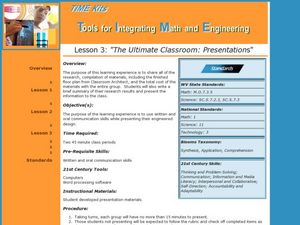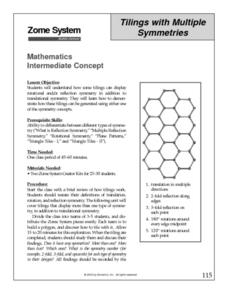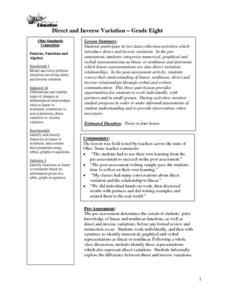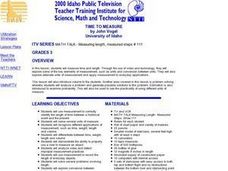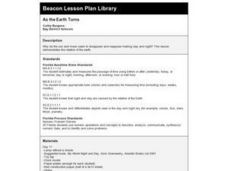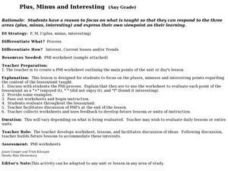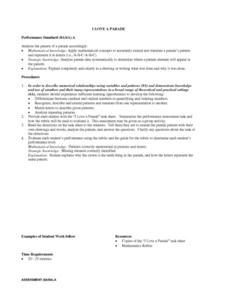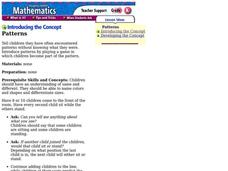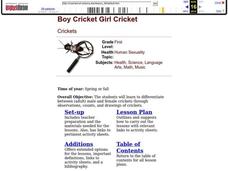Curated OER
The Ultimate Classroom: Presentations
Students create a classroom floor plan. In this ultimate classroom instructional activity, students create a floor plan to scale, determine a materials list with cost, and write a summary of their results. They create a PowerPoint...
Curated OER
What is an Antiderivative? Slope Fields
Students take the derivative of a function. For this calculus lesson, students define slope fields and what they are used for. They relate slope fields to the real world.
Curated OER
The Calculus Whiz Who Owned a Box Company
Young scholars use the relationship between volume and surface area to construct a box out of a piece of paper that maximizes volume using a table and by using graphing and calculus techniques.
Curated OER
Tilings with Multiple Symmetries
Students explore how some tilings can display rotational and/or reflection symmetry in addition to translational symmetry. Students demonstrate how these tilings can be generated using either one of the symmetry concepts and Zome System...
Curated OER
Super Sort
Students sort objects based on one characteristic. They define the term "attribute" and give examples of attributes of objects. Students explain their reasoning for sorting objects into groups.
Curated OER
Approximating Measures
Fourth graders complete a worksheet about approximate measurements. For this lesson on approximation, 4th graders compare the wingspan of a given bird to the wingspan of other birds and classroom objects.
Curated OER
Solving Equations By Systematic Trial
Learnerss solve equations using guess and check. For this algebra lesson, students solve linear equation using the systematic trial. They isolate and identify the missing variable using non tranditonal methods.
Curated OER
Best lesson in the whole world!
Students study the concept of fraction using mathematical reasoning. In this problem solving fraction lesson, students use various methods to explain their reasoning in solving fractions. Students use a number of different prompts to...
Curated OER
Direct and Inverse Variation
Eighth graders participate in two data collection activities that involve direct and inverse variation. In the pre-assessment, 8th graders categorize numerical, graphical, and verbal representations as linear or nonlinear and determine...
Curated OER
Coordinate Graphing
Students practice basic coordinate graphing and plotting points on the coordinate axis. In this geometry lesson, students are introduced to ordered pairs, and the x and y axis.
Curated OER
Time To Measure
Third graders measure time and length. Through the use of video and technology, they explore key elements of measurement, such as units and conversion between units. They explore alternate units of measurement and apply measurement to...
Curated OER
As the Earth Turns
First graders explore why the sun and moon seems to disappear and reappear creating day and night.
Curated OER
New Kids on the Block
Second graders identify and describe in their own language, the following 2-dimensional and 3-dimensional shapes: triangle, square, oblong (non-square rectangle), circle, oval, pentagon, hexagon, diamond, box, cylinder, and sphere. They...
Curated OER
Perplexing Perimeters
In the process of constructing their own "rulers" Students develop a sense of the size of a centimeter and meter. Students select the appropriate "ruler" for the tasks. Finally, 3rd graders calculate the perimeter of objects using...
Curated OER
Activity Plan 5-6: What's In a Name?
Students use family names to gather and analyze data. For this counting lesson, students use graph paper to help organize their data and then, in a staircase fashion, organize the names from longest to shortest so they can answer...
Curated OER
Plus, Minus and Interesting
Students identify the main ideas or topics of a lesson or unit using the plus, minus and interesting graphic organizer. In this main idea or topic lesson, students examine the use of the PMI graphic organizer. They describe the item they...
College Board
Why We Use Theorem In Calculus
Young scholars read an article to explain the reasoning behind theorems. In this calculus lesson, students understand the underlying principles of theorems and how it helps them make sense of the problems. They know why they do what they...
Curated OER
I Love a Parade
Students receive a worksheet that describes a parade. They tell what the 10th item in the parade will be. Students draw the parade, and tell the pattern they see using letters. Students design their own parade with the same pattern. They...
Curated OER
Patterns
Students make patterns. In this early sequencing lesson, students observe and state a pattern when they see one. The teacher begins be using students to demonstrate a pattern with half of the children standing and every other child sitting.
Curated OER
A Cosmic Cafeteria
Students indentify and differentiate between transit and surface food systems. Students measure energy that is released by various foods. Students compare and contrast cooking with solar energy on earth and what they might have learned...
Curated OER
Boy Cricket Girl Cricket
First graders differentiate between (adult) male and female crickets through observations, counts, and drawings of crickets.
Curated OER
Matching Pairs
Learners take turns matching the appropriate shapes (listing coin values) to those with numerical values listed on them. When students are successful, they win a blank shape for their collection.
Curated OER
Twisters
Learners differentiate between the terms 'tornado watch' and 'tornado warning' and simulate the conditions that produce tornadoes. They read "Night of the Twisters" by Ivy Ruckman and conduct an experiment using two-liter plastic...
Curated OER
Are You Money Smart?
Learners figure out and discuss the irony of this coin-centric poem. They also practice persuasive letter writing, and identify and count coin/money values.


